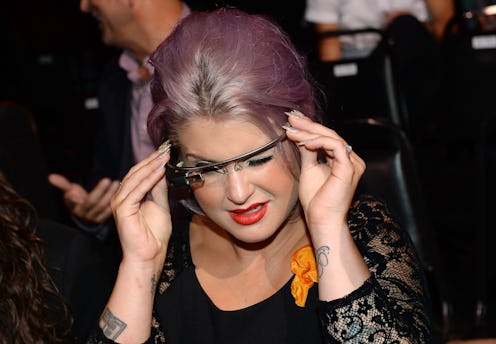News
These Health Gadgets Are Amazing
This week, the FDA approved Cefaly's migraine headband; a battery-powered device that looks like something Elsa should be wearing in Frozen. The headband prevents migraines using electrical signals which stimulate the nerves in your head through an adhesive electrode. The headband will also make you look like you should be at the helm of a starship — but that's just an added bonus.
Even though the Cefaly is making a splash, cool medical gadgets are nothing new. With trends like remote medicine, 3D tissue printing, and wearable health and fitness tech dominating medical gadgetry, we've seen some futuristic improvements to healthcare that will make our lives like the the Jetsons. And don't worry, we're not talking about Healthcare.gov.
The Medical Google Glass
Even though Google Glass is popular on the red carpet and the runway, it's also coming to an emergency room near you: emergency room doctors at various hospitals across the country have begun using Google Glass to identify patients and pull up charts instantly. Although this may not sound revolutionary, the use of an app that keeps medical information off Google’s servers is the real medical marvel here. Google has explained it a few times now, but the gist of it is that medical professionals have found a way to keep Google or the NSA from going through your chart, while making doctor's visits more efficient.
Google glass has also been used in surgery, and is in testing at Shriners hospitals for possible applications for children with disabilities. Very soon we might expect doctors to wear scrubs, white coats, and a Glass.
Wearable Sun Sensors
Melanoma is the most common cancer for people from age 25-29, and it's on the rise. Although many ad campaigns have warned Americans about the dangers of tanning, we clearly aren’t listening, since one person dies of melanoma every hour. Melanoma cases in young women are becoming more and more common, and skin cancer is setting in earlier in women than ever before.
Luckily, this cute wearable sun tracker is coming to rescue us. The aptly-named June device tracks your real-time sun exposure, and reminds you when you need SPF, or to go inside for a while. Pale people of the world rejoice: someone has found a stylish way to remind you about sunscreen.
Webcam Check-Ups
Remote health is all the rage right now. From doctors who track your fitness using wearables, to the possibility of vitals monitors that are embedded in you skin, your doctor wants to come to you. The advantage of the webcam-based health monitor being developed at the Harvard-MIT Health Sciences and Technology program is that it can track fitness throughout the day without intruding into your life or personal space.
Students at Harvard-MIT have figured out how to measure heart rate using a webcam alone, and hope that this leads to remote, round-the-clock monitoring of other vitals as well. This may sound a little bit like Big Brother, but if the camera has an off switch, it sounds like the future of check-ups.
3D Organ Printing, Now With Blood Vessels and Skin
3D printing is nothing new, but advances in 3D tissue printing have finally got the science of “printing you a new heart” off the ground. Researchers at Harvard finally figured out how to get blood to engineered organs, which is a crucial step in being able to create a functional kidney, for example.
Doctors have also taken 3D printing out of the laboratory and into the operating room. In the UK, doctors were able to fix severe facial injuries caused by a motorcycle crash using a combination of CT scanning and 3D printing. Their revolutionary technique restored the symmetry to a British man's face, which had been crushed in a motorcycle accident.
A Pacemaker for Every Heart
Gone are the days when pacemakers look like beepers. This space-aged pacemaker is a membrane that slides over the heart; keeping it in check while being personally tailored to the heart in question. Once again, 3D printing is behind this great medical gadget: each pacemaker is 3D-printed to fit around the patient’s heart, then it regulates heartbeat using electrodes. Watch the pacemaker operate a rabbit heart, and be amazed.
